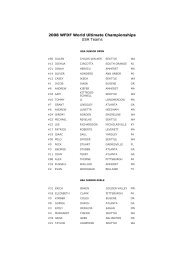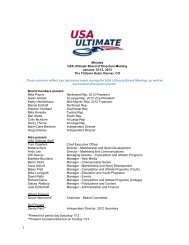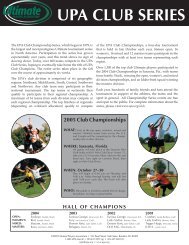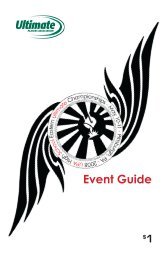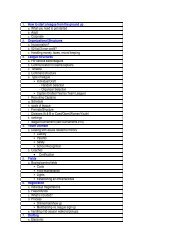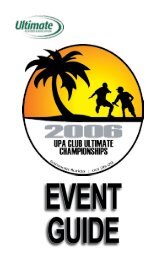Rhythms of Life Disc Skills Curriculum Grades 3-7 - USA Ultimate
Rhythms of Life Disc Skills Curriculum Grades 3-7 - USA Ultimate
Rhythms of Life Disc Skills Curriculum Grades 3-7 - USA Ultimate
You also want an ePaper? Increase the reach of your titles
YUMPU automatically turns print PDFs into web optimized ePapers that Google loves.
• To generate more power, as the arm begins its forward motion shift the weight from the back(pivot) foot to the front foot.Curving the BackhandTo effectively curve the backhand, kids need to understand how the flight <strong>of</strong> the disc is determinedby the angle <strong>of</strong> the disc upon release. When introducing this subject, it can be fun for teachers totake a "Guided <strong>Disc</strong>overy" approach (i.e. "Let's see what happens if we release the Frisbee at thisangle…").There are three basic trajectories for a backhand:• Straight: <strong>Disc</strong> flies straight and levelTo throw the Frisbee straight and level, the Frisbee must be level (flat and parallel to theground) as it is released.• Outside-In (aka “Bender"):Righties - <strong>Disc</strong> curves from left to right.Lefties - <strong>Disc</strong> curves from right to left.To throw a "Bender," the outside edge (the side <strong>of</strong> the disc that is farthest from the body)is tilted up as the Frisbee is released. To do this the wrist must be flexed upwards (fingerspointed slightly up) as one throws.• Inside-Out:Righties - <strong>Disc</strong> curves from right to left.Lefties - <strong>Disc</strong> curves from left to right.To throw an Inside-out, the outside edge (the side <strong>of</strong> the disc that is farthest from the body)is tilted down as the Frisbee is released. To do this the wrist must be cocked down (fingerspointed down) as one throws.It’s fun to make the disc curve! You can play for a curve by aiming to the left or right <strong>of</strong> your targetand adjusting the angle <strong>of</strong> release accordingly.By watching the trajectory <strong>of</strong> the disc, a student can deduce whether they used too much or notenough angle on the release.The Forehand or "Flick"This is a fantastic throw to teach. It's easier than it looks (and it looks very cool). It can be thrownas far as a backhand with much less arm movement and physical exertion. It's crucial for <strong>Ultimate</strong>.PreparationIt's a good idea to repeat the loosening the wrists exercises described earlier in the Backhand section.Loose wrists are arguably even more useful in the flick than in the backhand.Stance• As in the backhand, players must establish a pivot foot. (Righties pivot on their left foot, Leftiespivot on their right.)• The step is to the same side as your throwing hand. Do not step across the body!• Unlike the backhand (where the step is made towards the target), the flick is thrown by steppingto the side <strong>of</strong> the target. Thus, both shoulders are open, facing the target when the throwis made.9



